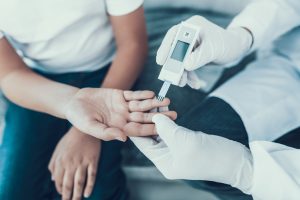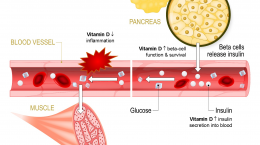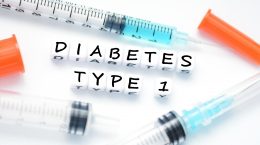Published on July 5, 2019
Last July, GrassrootsHealth launched a new project, the D*action Type 1 Diabetes Prevention project, to help identify potential changes in type 1 diabetes (T1D) diagnosis and autoantibody status that may result from actions taken (such as increasing the amount of sensible sun exposure, fatty fish in the diet, and/or supplements) in response to vitamin D and omega-3 fatty acid testing and education. The presence of islet cell autoantibodies (such as IAA, GADA, IA-2A, ZnT8, and ICA) indicates an autoimmune response against the cells of the pancreas, and is strongly associated with development of T1D. Evidence suggests a role of vitamin D and omega-3 in possibly reversing or stopping progression from developing autoantibodies to a T1D diagnosis. While there have been several published trials and case studies on this topic, such as the one below, the D*action field trial may help demonstrate the effect even further.
What is type 1 diabetes?
 Type 1 diabetes is an autoimmune disease in which the insulin producing cells in the pancreas (beta cells) are suppressed or destroyed by the body’s immune system, causing insulin production to diminish. With the diagnosis of diabetes, care must be taken to stabilize and maintain blood glucose levels; this is usually achieved with insulin injections. Any measure to protect remaining pancreatic beta cells also becomes a priority.
Type 1 diabetes is an autoimmune disease in which the insulin producing cells in the pancreas (beta cells) are suppressed or destroyed by the body’s immune system, causing insulin production to diminish. With the diagnosis of diabetes, care must be taken to stabilize and maintain blood glucose levels; this is usually achieved with insulin injections. Any measure to protect remaining pancreatic beta cells also becomes a priority.
How could vitamin D and omega-3 influence T1D?
Vitamin D and omega-3s have demonstrated anti-inflammatory effects and have also been shown to play a role in regulating the immune response. Because of this, it has been hypothesized that both may have a protective effect on residual beta cells for those with T1D.
Case study demonstrates reversal effect of vitamin D and omega-3 on T1D
A case report by Cadario et al. describes the effect of vitamin D and omega-3 on the status of an 8 year old boy with diagnosed T1D. Upon diagnosis, his vitamin D serum level was 26 ng/ml (64 nmol/L); his AA:EPA ratio, measured a few months after diagnosis and before omega-3 supplementation, was 33.7.
He began supplementation with 1000 IU vitamin D per day and subsequently added an omega-3 supplement at a dose of 55-60 mg/kg/day (500 mg DHA and 1000 mg EPA per day, on average). Within a month of starting the vitamin D supplementation, insulin doses were reduced, and blood glucose began to return to the normal range spontaneously, without the need for frequent injections. Insulin need continued to decrease after the addition of omega-3 supplement.
Approximately 11 months after omega-3 supplementation began, the child showed a near-normal blood glucose, with an HbA1c of 5.8 (compared to 9.6 at baseline) and required only .05 IU/kg/d of insulin, once in the evening, compared to his baseline need of .39 IU/kg/d throughout the day. His vitamin D level reached 42 ng/ml and the AA:EPA ratio dropped to just below 3 (as shown in the chart below).
Conclusion
This case report documenting the addition of 1000 IU/day vitamin D and 1500 mg/day omega-3 fatty acids supports the concept that such supplementation “could represent a safe and cost-effective strategy that may be of assistance to halt the progression of Type 1 Diabetes.”
Forty-eight leading vitamin D researchers have recommended a 25(OH)D level of 40-60 ng/ml (100-150 nmol/L) for the prevention of many chronic diseases, such as T1D. Other researchers have suggested an AA:EPA ratio of <3 is a target for reducing rates of chronic inflammation. This case study demonstrates the potential effects of reaching these targets in a child with diagnosed T1D.
Do you know your levels of vitamin D and omega-3?
Be sure to know if you are getting enough vitamin D and omega-3s by testing your levels! Daily steps such as increasing sun or vitamin D supplements may be necessary to maintain a level between 40-60 ng/ml (100-150 nmol/L), and increasing omega-3s in the diet or through supplementing may be necessary to keep your Omega-3 Index at a level of at least 8% and AA:EPA ratio at or below 3. Find out your levels today! Log on to the shop (click the link below) to get your tests and see for yourself if your levels can be improved.
Make sure you track your results before and after, about every 6 months!
Click Here to Access the Shop Page
How can I track my nutrient levels and intake?
To help you track your supplement use, dietary nutrient intake, and nutrient levels, GrassrootsHealth has created an online tracking system called myData-myAnswers. For each specific supplement, you can track what days you take it, how much, and many other details. You can also track your nutrient intake from dietary sources. Check it out today!








